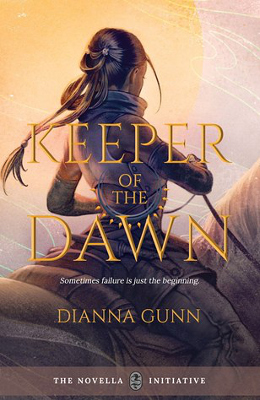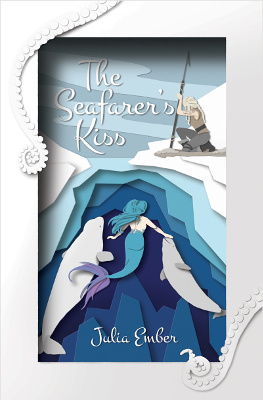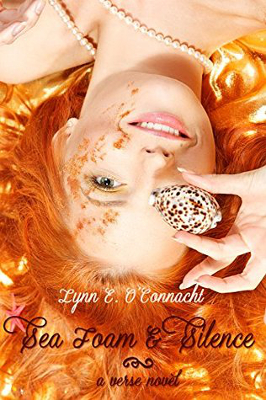 First Published: 18th April, 2017
First Published: 18th April, 2017
Genre: Young Adult Fantasy / Novella
Available: Out of Print
Lai has trained all her life to become a priestess, like her mother and grandmother before her. When she fails the test, she runs away and finds her people aren’t the only ones with that religion.
This is a novella of unfortunate implications. That’s going to take some explaining, so I’ll start with the simpler stuff. I’m also not talking about much which isn’t in the book description, but I’d note the official description covers most of the plot.
One thing I did like is the two cultures with the same religion are both shown as being equally religious. Often in these situations, there will be one group who are the true believers and one group with a corrupted version. Here, the goddesses are watching over them both. There isn’t one true version of the religion and they both have holes in their history knowledge.
The writing flowed along well enough. Though the story was predictable, that’s not always a bad thing for a light read. It has some adventure and some romance, which is what it promised. It did tend to jump huge chunks of time, which left gaps in the relationships and worldbuilding. None of that would have been that bad, if it wasn’t for the rest.
There’s a black/white means bad/good thing going on from the start, though it’s more subtle at the beginning. Lai is attacked by someone with black hair, when Lai has white-blond hair (described as silver and as blond at various points). The community is mostly lighter people, so the darker-haired antagonist is noticeable. Given a choice of horses, Lai chooses the white one as superior to the brown and black ones. On their own, these things might not register, but then Lai is off visiting the lands to the north, and the unfortunate implications really get going.
To understand my reservations, there needs to be some understanding of a group of connected stereotypes. They’re connected by superficial similarities in appearance, rather than the groups involved having much else in common. Often tanned, curly dark hair, hooked nose, sometimes with other features like large ears, thick lips, or tiny eyes. Things that set a person apart as different compared to lighter Northern Europeans. They can’t be trusted, they’re greedy, the men will lust after women, the women are temptresses, and they’re probably all doing some dark magic on the side. There are some variations on the theme, but it’s often difficult to separate exactly which group is being targeted, because it’s a combination of all of them. Commonly included are Jewish people, Romani people, and pagans / witches. The last of those makes more sense knowing that the early inhabitants of the British Isles had darker complexions, with pale blonds moving in later. So, with some vague handwaving to justify it, obviously all people with darker complexions are doing evil witchcraft. At a minimum, they’re very bad people.
When Lai crosses the border, she ends up working for a man called Calvin. He is a travelling merchant and is shifty from the start. I was thinking Romani stereotypes at this point. He also makes suggestive comments to Lai, despite him being married and her being a teen. This could be falling into the Romani men lusting after pure white women thing (and it happens again later, with a travelling bard, because you can’t trust travellers). But the lust thing can also be applied to Jewish men. Which brings me to how he’s really rich and hoarding wealth, which is a common Jewish stereotype. This is reinforced by northerners being monotheists. To finish off, the magic in the north has shady stuff like blood oaths going on, which comes back to the paganism and witchcraft connections.
This is all tied up with the physical side. There aren’t any hooked noses here, but there are beady eyes and northerners are overall darker (especially compared to white-blond Lai). Calvin is also fat, and described as a disgusting and gluttonous eater. An anti-fatness stereotype in itself, but one that is frequently associated with the greedy Jewish stereotypes.
I’d also note the trainee in Lai’s new home who is violently against her also happens to be the one with curly black hair. Everyone described as having black hair is antagonistic to Lai in some way.
These things are so common they’re often not noticed. Or when they are, people argue that they’re too general to pin down to one specific group as the target, so they’re not really targeting anyone. I agree the former can be tricky, as it often covers a mashup of different stereotypes. I’m sure people can pick out some I missed. But it doesn’t make the latter true. It just means the targets are widespread.
More obvious as an eyebrow-raiser is she’s a desert nomad from a culture that made amazing Ancient Near East / Rome inspired structures, and her favourite weapon appears to be Chinese butterfly knives under another name, but people from those cultures aren’t in the story. The cultural aspects are there, but not the people.
The reason I picked up the book is Lai is asexual, which is what I thought I’d be talking about. Instead, you got a long ramble about the ways stereotypes interact. But this is partly because being asexual didn’t come into it much until later. I’d have liked more tell than show here, because showing meant creepy sexual situations. Men tried to get Lai to have sex with them. The new community happens to have a fertility festival where people are supposed to have sex. It’s sort of optional, but not really, as Lai has to go to impress people and she’s coerced into dancing. The positive side is she isn’t coerced into sex and her romantic partner is okay with it once explained, though it does come with the statement that normal couples have sex. Not wanting sex was okay, but also abnormal. This was a mixed bag for me as a result. I’d have liked it a whole lot more without the creepy stuff and normality statements.
I didn’t note any disabled characters, but it’d be a bad world to be disabled, as health and fitness are assumed to be because of the gods. Priestesses have to be able to win battles to prove they’re favoured. Disease is assumed to be a divine punishment.
The worldbuilding is very binary, as men do this, and women do that, and it’s innate rather than simply being culturally enforced. In short, I don’t have a place in this world, except perhaps as the beady-eyed villain. But it does have two women in a relationship and one’s asexual, and for some readers, that might be enough.
[A copy of this book was received from the publisher for review purposes]
 First Published: 5th October, 2017
First Published: 5th October, 2017 First Published: 4nd May, 2017
First Published: 4nd May, 2017 First Published: 9th June, 2016
First Published: 9th June, 2016 First Published: 18th April, 2017
First Published: 18th April, 2017 First Published: December, 2015
First Published: December, 2015